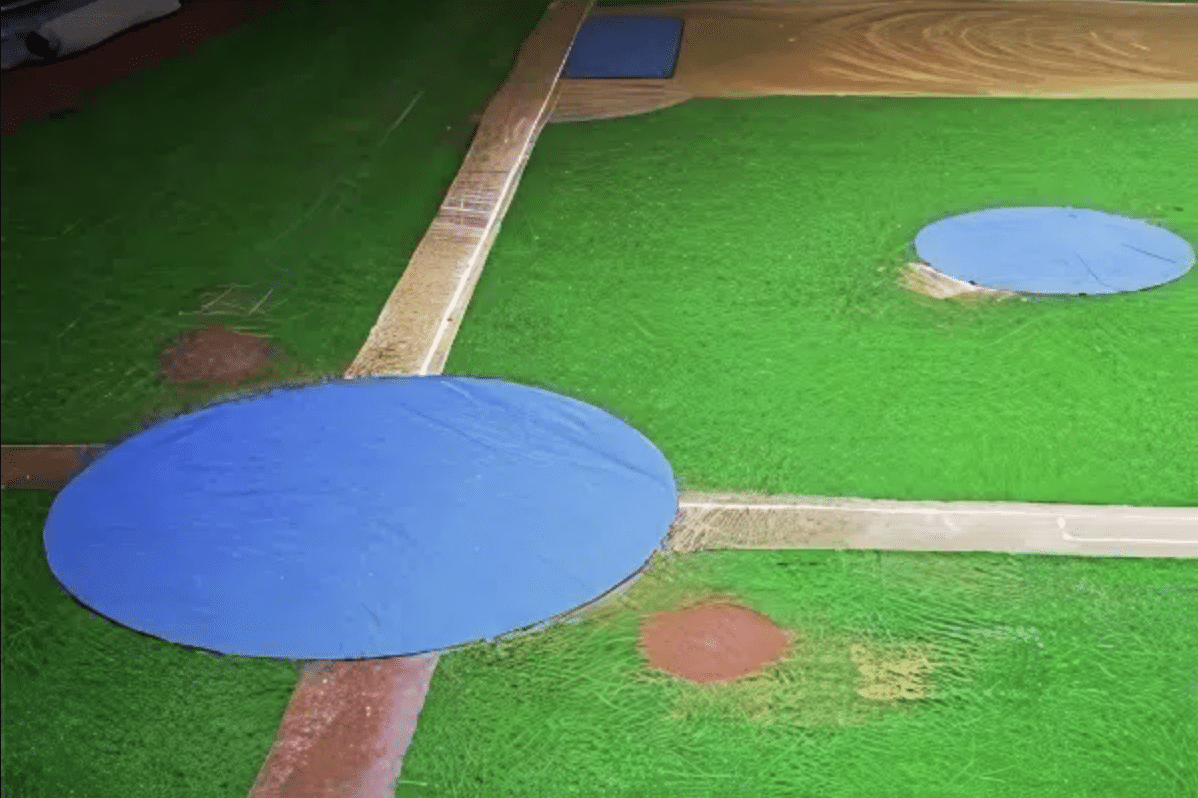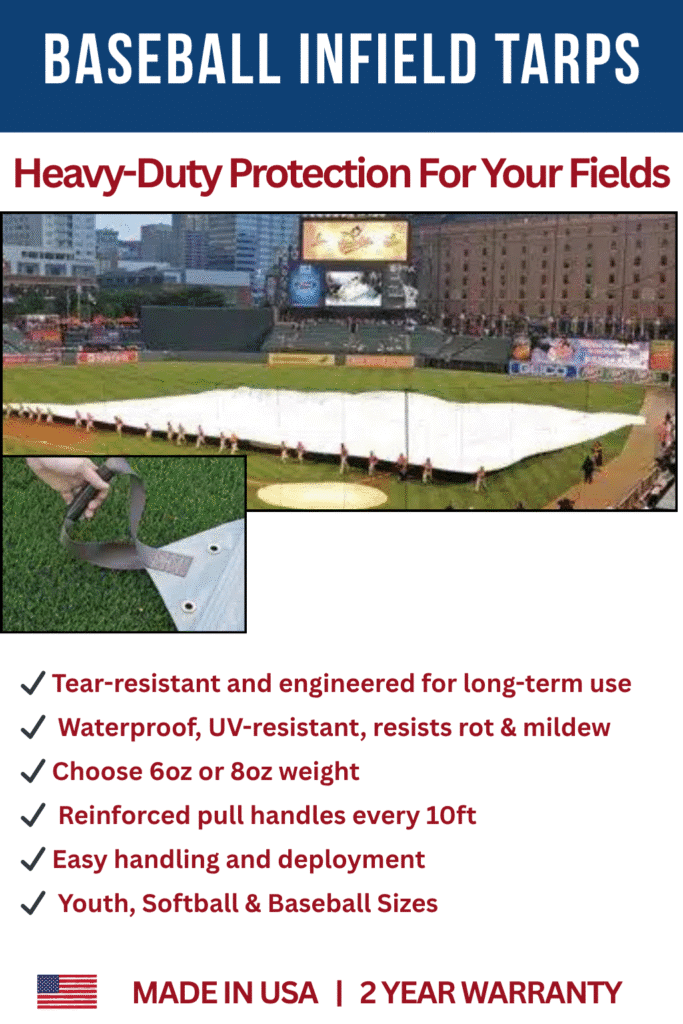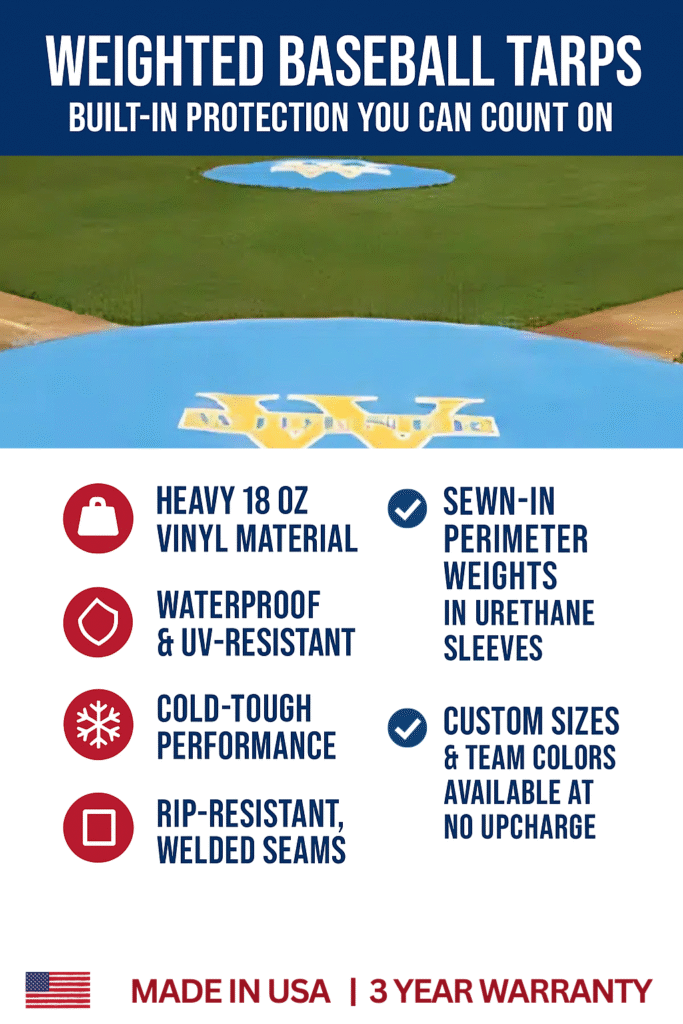Your baseball field is more than just dirt and grass—it’s a significant investment that demands proper protection. Every time rain threatens a game or practice, your field’s condition and playability are at stake. The right baseball tarp isn’t just an accessory; it’s essential equipment that preserves your field’s integrity and can save thousands in repair costs.
Since 1999, BaseballTips.com has helped coaches and athletic directors select the proper field equipment to maintain winning baseball programs. In this comprehensive guide, we’ll explore everything you need to know about baseball tarps, from full infield covers to specialized weighted tarps.
Ready to protect your field investment? Let’s dive in.
Table of Contents
- Understanding Baseball Tarps
- Infield Tarps
- Weighted Baseball Tarps
- Spot Covers and Specialized Tarps
- Selecting the Right Baseball Tarp
- Frequently Asked Questions
Understanding Baseball Tarps – Essential Field Protection
Baseball tarps are specialized protective covers designed to shield various parts of a baseball field from rain, snow, and extreme temperatures. Unlike standard blue tarps and concrete blocks (which we strongly advise against), quality baseball tarps provide reliable protection that preserves field playability and significantly reduces maintenance costs.
Why Baseball Tarps Matter
Field maintenance is about consistency and protection. A single heavy rainstorm can turn your carefully groomed infield into a muddy mess requiring hours of repair work. Proper baseball tarps provide:
- Protection against rain, snow, and excessive sun exposure
- Preservation of clay moisture levels in key playing areas
- Reduction in game cancellations and postponements
- Significant labor savings in field preparation time
- Extended lifespan of your field’s critical areas
As we emphasize at BaseballTips.com, “quality and cheap do not go together.” While budget constraints are real, investing in proper field protection pays dividends in reduced maintenance costs and improved playing conditions.
Want personalized advice on your field protection needs? Request a custom quote from our team of former coaches and players who understand both equipment needs and budget constraints.
Infield Tarps – Comprehensive Field Protection
Full Infield Covers: The Ultimate Protection
Full infield tarps cover the entire infield skin, providing maximum protection from severe weather. These large covers typically extend from the grass edge behind first and third base, across the infield, and into the outfield grass.
Key Features of Quality Infield Tarps:
- Material Thickness – Professional-grade tarps range from 6oz to 18oz vinyl or polyethylene
- UV Protection – Prevents material breakdown from sun exposure
- Reinforced Edges – Prevents tearing during deployment and removal
- Proper Sizing – Custom sizing ensures complete coverage of critical areas
Deployment Considerations
Full infield tarps require a team effort to deploy properly. The process typically includes:
- Storing the tarp on a storage roller for quick deployment
- Using 6-8 people minimum for safe handling
- Properly securing edges to prevent wind damage
- Following a consistent rolling/unrolling pattern
For programs with limited staff or volunteers, smaller sectional tarps or weighted options may be more practical. As Coach JP often reminds customers: “Choose equipment that matches your real-world maintenance capabilities.”
The True Cost of Rainouts
A single rained-out game can cost programs significantly in rescheduling fees, transportation, officials’ pay, and lost concession revenue. Quality infield tarps may seem expensive initially, but they quickly pay for themselves by preventing costly cancellations.
Need help determining the right infield tarp size for your field? Contact our field assessment team for personalized measurements.
Weighted Baseball Tarps – Modern Innovation in Field Protection
The Weighted Tarp Revolution
Weighted baseball tarps represent a significant advancement in field protection technology. Unlike traditional tarps requiring stakes or sandbags, weighted tarps feature built-in weight around their perimeters, allowing quick deployment by just 1-2 people.
Advantages of Weighted Tarps
- Quick Deployment – Can be positioned by a single person in under a minute
- Self-Securing – No need for stakes, sandbags, or additional anchoring
- Targeted Protection – Ideal for critical areas like pitching mounds and home plate
- Labor Saving – Reduces staff requirements for field protection
- Storage Efficiency – Takes up less storage space than full infield tarps
At BaseballTips.com, we’ve seen programs of all sizes benefit from weighted tarps. They’re particularly valuable for high schools and colleges where maintenance staff may be limited.
Weighted Vinyl vs. “Blue Tarps and Concrete Blocks”
As we emphasize to our customers, using standard hardware store tarps weighted down with concrete blocks is a field maintenance mistake. These makeshift solutions:
- Allow water seepage at contact points
- Create uneven weight distribution
- Result in tearing and frequent replacement
- Actually damage clay surfaces when removed
Proper weighted vinyl covers provide uniform protection and are truly a “buy-it-once” product that will serve your program for years.
Ready to upgrade from blue tarps to professional-grade weighted covers? Browse our weighted tarp options with options for every budget.
Spot Covers and Specialized Tarps – Targeted Protection
Critical Area Protection
While full infield tarps provide comprehensive coverage, specialized tarps for specific areas offer targeted protection for the most vulnerable parts of your field:
Pitching Mound Covers
Pitching mound tarps protect the most meticulously maintained area of your field. Quality mound covers:
- Maintain clay moisture levels
- Preserve landing areas and slope integrity
- Reduce daily maintenance requirements
- Typically measure 18′ or 20′ in diameter
Home Plate Covers
The batter’s box and catcher’s area experience intense wear and are expensive to rebuild. Home plate covers:
- Prevent water pooling in the most-used area of the field
- Help maintain batters box integrity
- Reduce daily maintenance time
- Typically measure 18′ or 20′ in diameter
Base Area Covers
Base area covers protect the sliding areas around bases, helping to:
- Maintain consistent sliding surfaces
- Prevent water accumulation at base cutouts
- Reduce maintenance time on base paths
- Typically measure 12′ to 14′ in diameter
Combining Coverage Strategies
Many successful programs implement a tiered approach to field protection:
- Daily use of weighted covers for mound and plate
- Base covers deployed when rain is forecasted
- Full infield tarp reserved for significant weather events
This strategic approach maximizes protection while minimizing the daily labor required for tarp management.
Looking for specialized protection for specific field areas? View our complete line of spot covers with options for every budget.
Selecting the Right Baseball Tarp – Making the Smart Investment
Key Factors in Tarp Selection
When investing in baseball tarps, several factors should guide your decision:
Material Quality
The material determines durability, water resistance, and longevity:
- Vinyl – Heavier but more durable, 18oz pro vinyl weight
- Polyethylene – Lighter but less durable, often 6-10oz weight. We do not offer this inferior product.
- UV Treatment – Critical for extending tarp life in sunny climates. Our models protect from UVA/B Rays.
Size and Coverage Requirements
Field dimensions and specific protection needs determine optimal sizing:
- Full infield tarps should extend at least 5′ beyond the infield skin
- Mound and home plate covers typically require 18′, 20′, or 26′ diameter
- Our Base covers are efficiently sized 10′ x 10′ squares.
Deployment Resources
Be realistic about your staff and volunteer availability:
- Full infield tarps require 6-8 people minimum
- Weighted tarps can be managed by 1-2 people
- Storage space availability must be considered
Budget Considerations
At BaseballTips.com, we understand budget constraints while emphasizing value:
- Professional-grade full infield tarps: $2,000-$5,000+
- Quality weighted mound/plate covers: $300-$800 each
- Base area covers are $200 for a set of 3.
As with all field equipment, we recommend investing in the best quality your budget allows. “Buy once, cry once” applies particularly to field protection equipment.
Team Branding Opportunities
Many programs view field tarps as both protective equipment and branding opportunities:
- Custom colors match team identity
- Logo imprinting creates professional appearance
- Sponsor placements can offset purchase costs
Quality field tarps with team branding present a professional image that players, parents, and administrators appreciate.
Ready to protect your field investment with quality tarps? Call our team at 1-800-487-7432 for personalized recommendations based on your specific field conditions and budget.
Frequently Asked Questions
How long should a quality baseball tarp last?
A professional-grade baseball tarp properly maintained should last 5-8 years for full infield covers and 7-10 years for weighted spot covers. Key factors affecting longevity include material weight, UV treatment, storage practices, and deployment care. Programs that properly fold, clean, and store tarps when dry will maximize their investment.
What’s the biggest mistake programs make with baseball tarps?
The most common mistake is choosing tarps based solely on initial price rather than quality and longevity. Using hardware store “blue tarps” weighted with concrete blocks is particularly damaging, as these makeshift solutions allow water seepage, create uneven pressure on clay surfaces, and require frequent replacement. Other common errors include improper storage (folding while wet) and using too few people for deployment, which leads to tears and premature replacement.
Can baseball tarps help with field moisture management beyond rain protection?
Absolutely. Strategic use of baseball tarps is essential for comprehensive moisture management. During dry periods, briefly covering mounds and plate areas after watering helps retain optimal clay moisture. In extremely hot conditions, tarps can prevent excessive drying and cracking of clay surfaces. Some programs even use light-colored tarps to reflect heat during summer months or dark tarps to increase soil temperature in early spring. Quality field covers are as much about maintaining ideal moisture levels as they are about rain protection.
What Baseball Programs Say About Quality Field Protection
“Investing in proper weighted mound and plate covers was the best equipment decision we made last season. We reduced our daily maintenance time by over an hour and haven’t had to rebuild our mound once since purchase.”
– High School Baseball Program, North Carolina
“After years of fighting with blue tarps and sandbags, we finally invested in a quality infield tarp system. The difference is night and day—faster deployment, better protection, and significantly less field repair after rain.”
– College Baseball Program, Georgia
Protect Your Field Investment Today
Your baseball field represents a significant investment in your program’s success. Proper protection with quality baseball tarps isn’t just about preventing rainouts—it’s about maintaining consistent playing conditions, reducing maintenance costs, and presenting a professional image.
At BaseballTips.com, we’ve been guiding baseball programs through equipment decisions since 1999. Our team of former coaches and players understands both equipment quality and budget constraints. We provide valuable insights to help teams make informed choices that enhance performance without overspending. Our expertise encompasses everything from bats and gloves to protective gear, ensuring that every player is equipped for success. For those seeking guidance, our professional baseball equipment selection tips will streamline the decision-making process.
Whether you need a comprehensive field protection system or targeted solutions for critical areas, we’re here to help you make informed decisions that will serve your program for years to come.
Ready to elevate your field protection strategy? Contact our team at 1-800-487-7432 (Monday-Friday, 10am-7pm EST) for personalized recommendations tailored to your specific needs and budget.
Remember, in field maintenance as in baseball: quality preparation leads to consistent performance.

Protect Your Field With Our Weighted Tarps
Keep mounds, plates, and bases dry with durable weighted spot covers.



